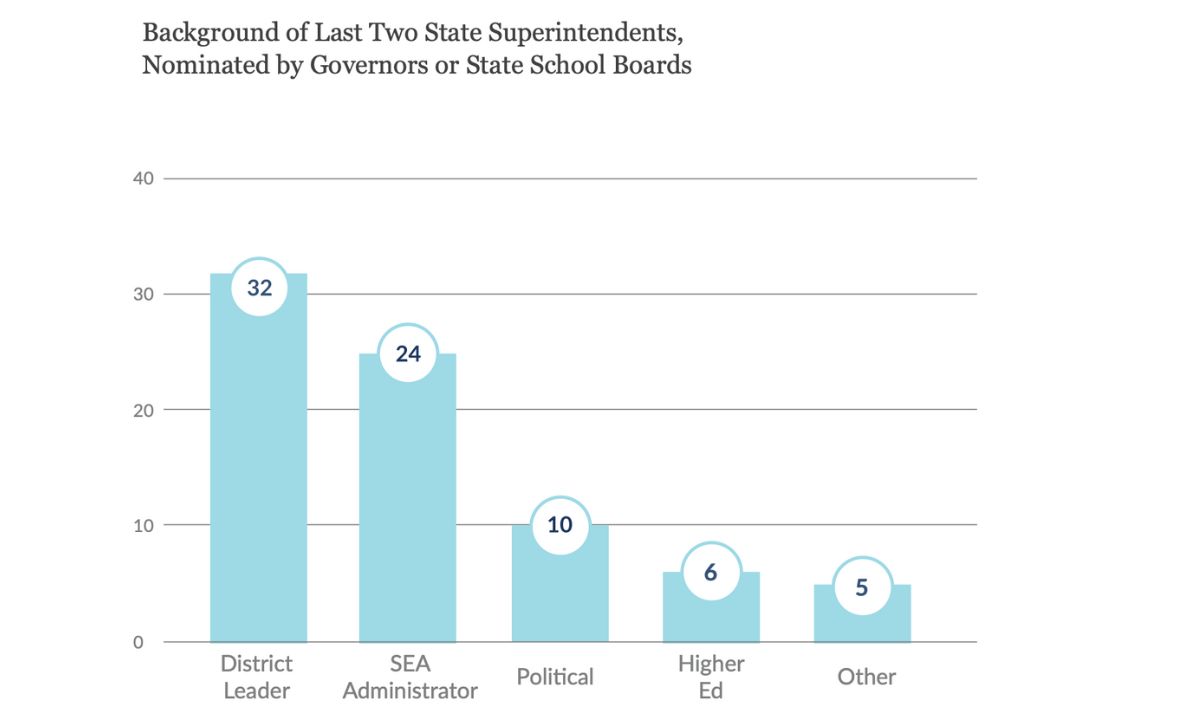Who Is Being Chosen for State Superintendent — and What Voters Need to Know
Nevins: Selections made by governors and boards can provide important information about the potential direction of statewide education politics.

Get stories like this delivered straight to your inbox. Sign up for The 74 Newsletter
Thanks to the Nov. 7 elections, three governors will be starting new terms next year. That means big decisions will soon be made about who will serve as the state superintendent and chief policymaker for each state education system.
Next year, another 20 gubernatorial and state board elections will take place that will impact state superintendent selection. Couple that with the fact that in the last two years over half of states had turnover in the state superintendent position, and it becomes clear that the next year in electoral politics could transform education leadership for the country.
Which is why we at ILO Group undertook new research to understand whom governors and state boards of education are choosing for these top jobs and understand emergent trends in appointees’ backgrounds.
The modern state superintendent of education plays a powerful role in shaping not just education systems and policies, but how districts operate and how students learn. Superintendents are also among the highest-profile public officials in their state. Their background and qualifications are major considerations for governors and state boards because of the powerful role that they play in shaping the future direction of a large body of public policy.
Our research found a number of commonalities and several notable differences across the 39 states (plus Washington, D.C.) that currently have governors or state board of education with partisan affiliations who are responsible for state superintendent appointments. For this study, we analyzed the last two superintendents nominated within these states.
Our research gleaned four key dynamics:
- Over half of the last two state superintendents in each state were school district or state education agency leaders. Of 77 total nominees, 32 were district leaders and 24 had backgrounds at the state agency. While Republicans also show a tendency to appoint individuals with political backgrounds, Democrats are more likely to elevate nominees with backgrounds in higher education.
However, even with that variation, both Republicans and Democrats have a strong preference for in-state education experience. Almost four of the five of the past two recent superintendents from every state came from a previous position in the education bureaucracy. This indicates that familiarity with a state’s education system appears to be highly valued by governors and boards, regardless of partisan affiliation.
- Democratic-led states choose a district leader for the top education job more than half of the time. Out of 34 selections, states led by a Democratic governor or Democratic-majority board nominated a district leader 20 times. Democratic governors often frame their choices of district leaders for state superintendent by emphasizing their deep experience in schools, experience as educators and close ties to the education establishment in particular as strengths.
For example, in 2020, Kentucky Democratic Gov. Andy Beshear lauded his appointed board’s choice, saying Jason E. Glass “has deep roots in Kentucky education, and his years of public education experience in classrooms, as superintendent and state director of education will help ensure our children come first.” In much the same way, Democratic New Jersey Gov. Phil Murphy touted his nomination of former Asbury Park School District leader Lamont Repollet in 2018 by noting his “real-world experience, both in and out of the classroom.”
In both cases, the governors emphasized the appointees’ teaching backgrounds as important experience in the role of state superintendent.
- Republicans are most likely to choose state education agency administrators but also frequently select district leaders and individuals with political backgrounds. Of the 41 selections studied, 11 were district leaders, 15 were agency administrators and nine appointees had a background that was primarily political — state legislators, governor’s policy advisers, etc.
- Candidates with political backgrounds are increasingly being selected for top jobs, and Republicans more frequently appoint leaders with political experience who are aligned with their policy priorities. Of the selections studied, Republicans chose appointees with political backgrounds nine times, while Democrats chose one appointee with a political background.
Here, too, the way that governors and their partners frame the appointments can provide insight into the reasoning behind their selection. For example, when Republican Gov. Eric Holcomb of Indiana nominated his former adviser Katie Jenner, the state Chamber of Commerce noted that by nominating someone “aligned with his policy priorities in such a key role … that enhanced level of cooperation and collaboration will make the state’s education direction clear and allow for more impactful efforts on behalf of Indiana students.”
Similarly, when state legislator Manny Diaz was nominated to serve as Florida’s superintendent, Republican Gov. Ron DSantis cited Diaz’s sponsorship of Senate Bill 148/House Bill 7 to eliminate “[critical race theory] and woke training in Florida schools and businesses” as a reason for his selection.
Our research, part of our Superintendent Research Project, underscores that the selection of a state chief school officer or superintendent is a major moment in the leadership of the governor or state board making the choice. Whom they pick and how they frame their selection may provide stakeholders and voters with important information about the potential direction of education politics in the state.
Beyond simply political signaling, though, understanding who the appointees are and how their backgrounds will inform the work is essential. These backgrounds and experiences give shape to the direction of education policy as leaders grapple with the pressing matters facing students, schools and states. With all that in the balance, educators, researchers and the public have good and compelling reasons to understand the trends in who is being appointed to state superintendencies.
Get stories like these delivered straight to your inbox. Sign up for The 74 Newsletter

;)
